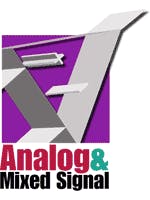As the information gateway to the digital world, analog and mixed-signal circuits are providing the breakthroughs in dynamic range, signal bandwidth, power, and size that increasingly are defining overall system performance. This holds true for a wide range of applications, from medical imaging equipment to driver safety systems, where considerations relative to signal sensitivity and selectivity are defining design specifications.
The Role Of The Data Converter
At the heart of the analog evolution lies the data converter. Today’s converters, whether high speed or precision, are expected to have the sensitivity to identify and capture extremely small signals within hostile, noisy environments—like a heart pulse in a room full of electronic gym equipment. They also are required to distinguish (or select) signals from a crowded world filled with other, often much stronger, signals. Just think of what’s involved with correctly routing a single cell-phone call.
Where they once were designed in as standalone components, data converters increasingly are pulling other system functions on chip to help engineers better and more easily capture, condition, and convert real-world signals. In many cases, converters are commonly paired with an array of sensors that can detect phenomena such as motion, pressure, light, or sound, again creating an information gateway for the digital processing that follows. This higher degree of integration provides the building blocks that are enabling system engineers to discover new levels of design flexibility and creativity.
Not long ago, the only important sensor you’d find in a cell phone was the microphone. Today’s phones sense motion, touch, and proximity among other variables. Indeed, in many respects the phone itself can be considered a sensor with its own set of special signal processing and converter requirements.
The number and the variety of new sensors in modern cars are even more impressive, and they include gyroscopes for stability control, sensors measuring driver awareness, cameras and proximity detectors for parking assistance, oil quality sensors, oxygen sensors, and tire pressure sensors. Each sensor has special signal processing needs, and new functions are being realized by combining the information from multiple sensors.
On one hand, the data converter operating in the center of a sophisticated, highly integrated analog block is influencing the features that engineers are designing into their products. On the other hand, data converters are defining system performance itself.
Real-World Applications
Consider medical imaging applications such as MRI, ultrasound, and digital X-ray. In each case, converter resolution directly influences the quality of the image that doctors and radiologists rely upon for their diagnoses. The resolution required at the high end of these systems is now extending to the 18- to 20-bit range. The speed of these devices is also increasing to the point that the image of a beating heart can be taken without synchronizing with the heartbeat through an ECG.
As very-high frequency systems such as cellular basestations, radar, medical imaging, and test equipment require higher performance and versatility, data converters have become a core component to build higher-precision but more adaptable systems. A major bottleneck as these speeds increase has been the high data-rate connections between the data converters and the digital processors. The latest implementation of the JESD204 standard, now JESD204B, reduces the complexity of the wiring while increasing the number of channels that can be synchronized and reducing power demands.
With complex, high-performing system designs, many applications are looking for breakthroughs in dynamic range or signal bandwidth, and most applications are looking for big reductions in size and power. To address these needs, the data converter has adapted and evolved from a component to a solution to meet the increasing demands brought on by higher speeds and higher-resolution systems.

